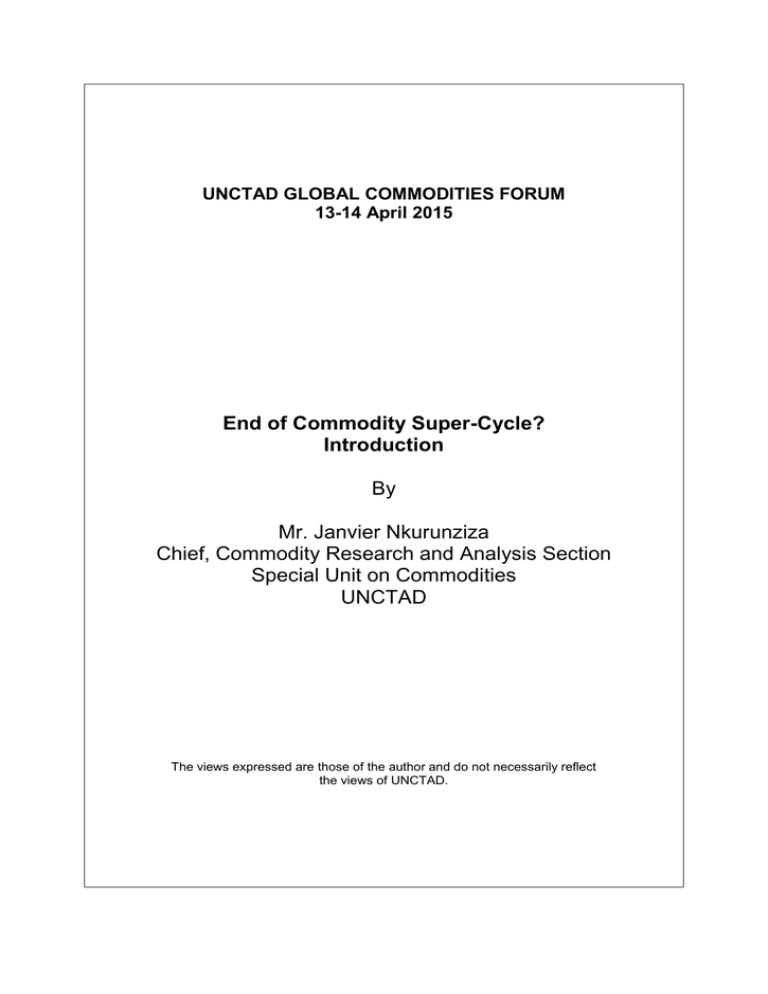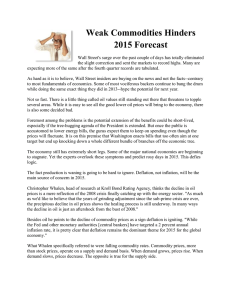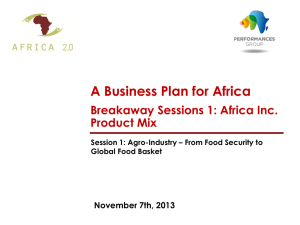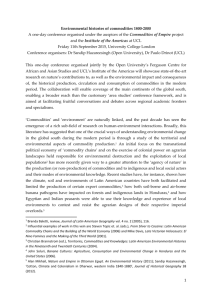End of Commodity Super-Cycle? Introduction By
advertisement

UNCTAD GLOBAL COMMODITIES FORUM 13-14 April 2015 End of Commodity Super-Cycle? Introduction By Mr. Janvier Nkurunziza Chief, Commodity Research and Analysis Section Special Unit on Commodities UNCTAD The views expressed are those of the author and do not necessarily reflect the views of UNCTAD. Global Commodities Forum 2015 14-15 April 2015, Geneva End of commodity super-cycle ? Introduction Janvier D. Nkurunziza Chief, Commodity Research and Analysis Section Special Unit on Commodities, UNCTAD Outline • Long term trends in global commodity markets • Main drivers of commodity prices over the last years • Prospects in global commodity markets • Concluding remarks Historical trends in commodity prices • • Global commodity markets : succession of boom and busts since 70s 2003-2011 : longest and broadest boom (commodity super-cycle) 350 Commodity super-cycle 300 250 200 150 100 2008 Financial crisis 50 1960 1961 1962 1963 1964 1965 1966 1967 1968 1969 1970 1971 1972 1973 1974 1975 1976 1977 1978 1979 1980 1981 1982 1983 1984 1985 1986 1987 1988 1989 1990 1991 1992 1993 1994 1995 1996 1997 1998 1999 2000 2001 2002 2003 2004 2005 2006 2007 2008 2009 2010 2011 2012 2013 2014 0 Non-oil commodities, nominal Source : Data from UNCTADStat Non-oil commodities, real terms Price indices of selected groups of commodities: Agricultural products and Minerals, ores and metals • • 2003-2011 : broad-based commodity cycle From 2011 : prices are declining but remain high compared to long term trends 400 Price indices, nominal (2000=100) 350 300 250 200 150 100 50 0 Non-oil commodities All food Agricultural raw materials Source : Data from UNCTADStat Minerals, ores and metals 1960 1961 1962 1963 1964 1965 1966 1967 1968 1969 1970 1971 1972 1973 1974 1975 1976 1977 1978 1979 1980 1981 1982 1983 1984 1985 1986 1987 1988 1989 1990 1991 1992 1993 1994 1995 1996 1997 1998 1999 2000 2001 2002 2003 2004 2005 2006 2007 2008 2009 2010 2011 2012 2013 2014 Price indices of selected groups of commodities energy markets 250 Price indices for crude oil, coal and natural gas (2010 =100) 200 150 100 50 0 U.K. Brent Coal, Australia Source : Data from IMF, IFS Natural gas, US …Cycle with heightened volatility Price volatility of selected groups of commodities (s.d. of annual price change) Percentage 30 25 20 15 10 5 0 Non-oil commodities All food 1981-1990 1991-2000 Agricultural raw materials 2001-2010 2011-2014 Minerals, ores and metals Main drivers of commodities prices over the past years • Market fundamentals : supply and demand 400 30 Wheat and maize prices vs. ending stock to use ratio 350 25 20 US$/tonne 250 200 15 150 10 100 5 50 0 0 2006 2007 2008 Wheat (Stock to use) Source : Data from AMIS 2009 2010 Maize (Stock to use) 2011 2012 Wheat, US$/tonne 2013 Maize, US$/tonne 2014 Stock to use ratio (percentage) 300 Main drivers of commodities prices over the past years • • Global economic factors Growth led primarily by developing and emerging economies, especially China GDP growth in groups of countries and China (2005 US dollars at constant exchange rate). 16.00 14.00 12.00 10.00 Percentage 8.00 6.00 4.00 2.00 0.00 2000 2001 2002 2003 2004 2005 2006 2007 2008 2009 2010 2011 2012 -2.00 -4.00 -6.00 China Developed economies Source : Data from UNCTADStat Developing economies excluding China Emerging economies World 2013 Main drivers of commodities prices over the past years China, leading importer in global commodity markets China's share in world imports for selected commodities (current dollars) Natural gas Sugar Barley Cereals (excl. wheat, rice, barley, maize) Milk, cream and milk products 2013 Petroleum oils 2011 Coal 2000 Natural rubber 1995 Aluminium ore and concentrates Copper ores and concentrates Cotton Nickel ores & concentrates Oil seeds and oleaginous fruits Iron ore and concentrates 0 10 20 30 40 Percentage Source :Data from UNCTADStat 50 60 70 Main drivers of commodities prices over the past years Global industrial production 20 Industrial value added, % annual growth rates (2000-2013) 15 10 5 0 2000 2001 2002 2003 2004 2005 2006 2007 2008 2009 2010 2011 2012 -5 -10 High income: OECD Source :Data from World Bank, WDI Sub-Saharan Africa Latin America & Caribbean China India Brazil 2013 01/1973 12/1973 11/1974 10/1975 09/1976 08/1977 07/1978 06/1979 05/1980 04/1981 03/1982 02/1983 01/1984 12/1984 11/1985 10/1986 09/1987 08/1988 07/1989 06/1990 05/1991 04/1992 03/1993 02/1994 01/1995 12/1995 11/1996 10/1997 09/1998 08/1999 07/2000 06/2001 05/2002 04/2003 03/2004 02/2005 01/2006 12/2006 11/2007 10/2008 09/2009 08/2010 07/2011 06/2012 05/2013 04/2014 Main drivers of commodities prices over the past years US dollar exchange rate and monetary policy 350 140 US$ Index vs. Non-oil Commodity price Index 300 120 250 100 200 80 150 60 100 40 50 20 0 0 UNCTAD Non-oil commodity price index, nominal Source : Data from UNCTADStat and US Federal reserve US Dollar Index, nominal (right axis) Main drivers of commodities prices over the past years Other factors Macroeconomic policies in developed economies • Expansionary policies Financialization of commodity markets • Also underpinned volatility in the markets Energy prices transmitted to agricultural commodity and metals markets Exogenous shocks • • • Weather patterns Environmental concerns Trade policies (quota, exports ban) Prospects in commodity markets (?) Agricultural commodity markets Upside risk factors Downside risk factors • Comfortable stocks helped by good crop conditions • Monetary policies in US (strong US dollar, increase in interest rate following the end of US stimulus plan) • Slower global economic growth • Low energy prices •Recovery in the US economy •Increased demand from emerging economies •Adverse weather patterns Prospects in commodity markets (?) Minerals, ores and metals Upside risk factors Downside risk factors • Gloomy economic prospects of industrialized economies (esp. the Euro zone) • Slower growth in emerging economies, esp. China • Economic restructuring in China away from investment to consumption (downside risk for iron ores and copper prices ) • Strong US dollar, high interest rate (end of US stimulus plan) • Low energy prices • Recovery in the US economy • Demand led by emerging economies such as India • Export restrictions • Economic restructuring in China away from I to C (upward pressure on zinc, aluminium, tin, lead prices) Prospects in commodity markets Energy Upside risk factors Downside risk factors; • Gloomy economic prospects in industrialized economies; • Slower growth in emerging economies, esp. China • Good supply of conventional and nonconventional oil • Strong US dollar • Recovery in the US economy; • Geopolitical tension disrupting oil production • Rebound in oil demand (?) • Production disruption from OPEC and Non-OPEC countries (?) • Slowing of shale production Concluding remarks • Forecasting price trends in commodity markets: a challenge! • Commodity prices have been easing but remain relatively high compared to their pre-2003 levels • From short to medium run, much factors are likely to be downside risks in global commodity markets: - Oversupply Gloomy global economic growth Low energy prices Concluding remarks (ctnd) • Then, commodity prices are most likely to moderate further in coming months (short term) • Declining prices have adverse effects on the terms of trade and macroeconomic performance of CDDCs • From medium to long term… high uncertainty : balance or imbalances between downside/upside risks factors • Long term policies in CDDCs should therefore prioritize economic diversification to face the uncertainty THANK YOU








